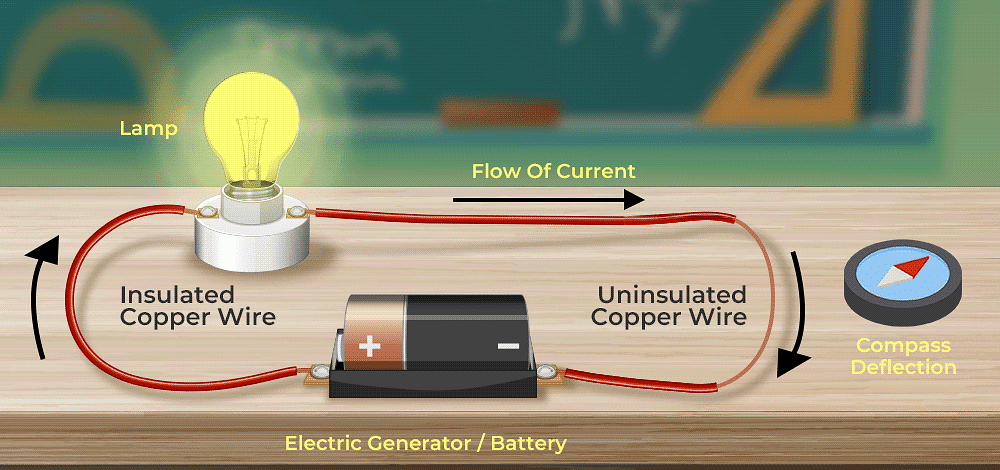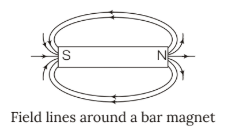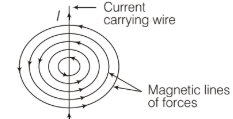Notes: Electricity and Magnetic Effect of Current | Science & Pedagogy Paper 2 for CTET & TET Exams - CTET & State TET PDF Download
Electricity involves the movement of electric charges and stands as one of the most widely used sources of power, encompassing both static and current electricity. Heating, chemical reactions, and magnetic effects are all connected to various relationships between current, voltage, and resistance. Electromagnetism, a fundamental interaction, finds extensive applications in our daily lives.

Electric Charges and Its Properties
In the sixteenth century, the English scientist William Gilbert discovered that certain substances can attract light objects when rubbed with specific materials. These substances are said to be charged, and charges can be either positive or negative. Like charges repel each other, while unlike charges attract.The SI unit of charge is the Coulomb (C). The force between charged particles is governed by Coulomb's law, which states:
F = k (q1 q2) / r2
where F is the force, q1 and q2 are the charges, r is the distance between them, and k is a proportionality constant. This force is known as the electrostatic force.
A comb attracting small pieces of paper is an example of electrostatic force in action.
1 Coulomb = 6.24 × 1018 electrons
Conductors, Insulators, and Semiconductors
Substances are classified based on their ability to conduct electricity:
- Conductors: Materials that allow electricity to flow freely, e.g., copper, silver, graphite, and salt solutions.
- Insulators: Materials that do not allow electricity to flow easily, e.g., rubber, glass, and plastics.
- Semiconductors: Materials with electrical conductivity between that of conductors and insulators, e.g., silicon and germanium.
1 Coulomb of charge flowing through a circuit in 1 second constitutes 1 Ampere (A) of current. Other units of current include milliampere (mA) and microampere (µA).
Key Points
- Metals are known for their excellent conductivity and are commonly used in electrical applications.
- Distilled water is typically a poor conductor of electricity. However, when salt is added to distilled water, its conductivity significantly increases due to the presence of ions that facilitate the flow of electric current.
- Acids are generally good conductors of electricity because they dissociate into ions in solution, which can carry electric charge.
- Air is not an effective conductor of electricity under normal conditions, as it lacks free ions or electrons to carry the electric charge.
Electric Current
Electric current is the flow of electric charge (electrons) through a conductor over time. The current I is given by:
I = q / t
where q is the charge and t is the time. The SI unit of current is the Ampere (A), with other units including milliampere (mA) and microampere (µA).
The direction of conventional current is opposite to the flow of electrons, from the positive to the negative terminal.
Types of Current
- Direct Current (DC): In DC, electric current flows steadily in one direction. This type of current has a frequency of zero since there is no change in direction. DC is commonly used in batteries, electronic devices, and solar panels.
- Alternating Current (AC): In AC, electric current reverses its direction at regular intervals. This type of current is used in households and industries for powering electrical appliances. The frequency of AC varies by region; for example, it is 50 Hz in Europe and 60 Hz in the Americas.
Measuring Electric Current
- An ammeter is an instrument used to measure electric current in a circuit. It is connected in series with the circuit to ensure that the same current flows through the ammeter as through the circuit.
- In an AC circuit, the current is often measured in terms of its root mean square (RMS) value, which is the equivalent DC value that would produce the same heating effect in a resistor. The RMS value of the electromotive force (emf) in an AC circuit is calculated by dividing the peak emf (E0) by the square root of 2 (√2). This is represented by the formula: RMS emf = E0 / √2.
Electric Potential and Potential Difference
For charges to flow in a conductor, there must be a potential difference, typically provided by a battery. When connected to a circuit, this potential difference causes charges to move, creating an electric current.
The electric potential difference (V) between two points in a circuit is defined as the work done (W) to move a unit charge (Q) from one point to the other:
V = W / Q
The SI unit of electric potential difference is the volt (V). Electric potential is the work done to move a unit positive charge from infinity to a point, and it is a scalar quantity measured in volts (V).
Ohm's Law and Resistance
Ohm's Law describes the relationship between the current flowing through a metallic wire and the potential difference across its terminals. According to Ohm's Law:
V ∝ I
or
V = IR
where V is the potential difference, I is the current, and R is the resistance of the wire.
The motion of electrons through a conductor is hindered by its resistance. A good conductor of a given size has low resistance, while an insulator of the same size has very high resistance. The SI unit of resistance is the ohm (Ω).
Factors Affecting the Resistance of a Conductor
The resistance of a conductor depends on the following factors:
- Length of the conductor (l)
- Area of cross-section (A)
- Nature of the material
The resistance of a metallic conductor is given by:
R = ρ (l / A)
where ρ (rho) is the electrical resistivity or specific resistance of the material, a characteristic property. The SI unit of resistivity is ohm-meter (Ω-m).
- Metals and alloys have very low resistivity and are good conductors of electricity.
- Insulators like rubber and glass have very high resistivity.
- Alloys generally have higher resistivity than metals and do not oxidize readily at high temperatures, making them suitable for electric heating devices like irons and toasters.
Example:
Problem: How much current will an electric heater draw from a 220 V line if the resistance of the heater is 50 Ω?
Solution: Given, V = 220 V and R = 50 Ω. Using Ohm's Law,
I = V / R
I = 220 / 50 = 4.4 A
Electric Circuits
An electric circuit is a continuous path for the flow of electricity through various electrical components, connected to a source such as an electric cell, bulb, switch, and wires.
A schematic diagram of the circuit represents different components using conventional symbols.
Resistors in Series
In a series circuit, the current is the same through each resistor, and the total voltage across the combination is the sum of the voltage drops across each resistor. The equivalent resistance (Requivalent) is given by:
Requivalent = R1 + R2 + R3
where R1, R2, and R3 are the individual resistances.
Resistors in Parallel
In a parallel circuit, the total current is the sum of the currents through each branch, and the voltage across each resistor is the same. The equivalent resistance (Requivalent) is given by:
1 / Requivalent = 1 / R1 + 1 / R2 + 1 / R3
where R1, R2, and R3 are the individual resistances.
Heating Effect of Electric Current
When electric current passes through a conductor, it generates heat due to the resistance it offers to the current flow. For example, an electric fan becomes warm if used continuously for a long time. This phenomenon is known as the heating effect of electric current.
Since the conductor resists the flow of current, work must be done to maintain the current. The amount of work done by a current flowing through a wire of resistance R during time ( t ) is given by:
W = qV
Since

Using Ohm's law V = IR , this becomes

This work or energy is dissipated in the resistor as heat. Therefore, the amount of heat \( H \) produced in time \( t \) is:

This is known as Joule’s law of heating. The law implies that heat produced in a resistor is directly proportional to the square of the current for a given resistance, directly proportional to the resistance for a given current, and directly proportional to the time for which the current flows through the resistor.
Electric Power
Electric power is the rate at which electrical energy is dissipated into other forms of energy. It is given by:
P = I2R
Since V = IR , power can also be expressed as \P = VI .
The unit of electric power is the watt (W). The commercial unit of energy is kilowatt-hour (kWh).
- 1 HP = 746 W
- 1 kW = 103 W
- 1 MW = 106 W
- 1 kWh = 3.6 × 106 J
Applications of Heating Effect of Electric Current
- Electric heating is used in devices like electric toasters, ovens, and heaters.
- Electric bulbs use the heating effect to produce light. The filament, usually made of tungsten (melting point 3380°C), retains heat and produces light.
- Bulbs are filled with inert gases like nitrogen and argon to prolong the filament's life.
Overloading
When too many electrical appliances are connected to a single socket, they draw a large current, causing overheating and potentially a fire. This is known as overloading.
Electric Fuse
- An electric fuse is placed in series in domestic circuits to protect them by stopping the flow of excessively high current. It consists of a wire made of an alloy or metal with a low melting point, which melts in case of short-circuiting or overloading.
- Electric heaters or room heaters contain a coil of wire called an element, often made of nichrome due to its high resistance.
- Traditional electric bulbs also waste energy by producing heat along with light. This wastage can be reduced by using fluorescent tube lights or compact fluorescent lamps (CFLs), though CFLs contain the toxic substance mercury.
The ISI mark (Bureau of Indian Standards) ensures the appliance is safe and minimizes energy wastage.
MCB (Miniature Circuit Breakers)
- Modern circuits use Miniature Circuit Breakers (MCBs) instead of fuses. MCBs are switches that automatically turn off when the current exceeds a safe limit.
- In household wiring, all electrical appliances are connected in parallel.
- The live wire is covered with red insulation, while the neutral wire is covered with black insulation. To avoid electrical shocks, the metal body of electrical appliances is earthed, connecting to a metal plate deep in the earth near the house.
Short Circuit
- A short circuit occurs when the live wire and neutral wire touch directly, causing a large current to flow through the household wiring.
Magnets
Magnetic Material
Materials that can attract magnetic substances (such as cobalt, iron, and nickel) are called magnets. A magnet has two poles: the North pole (N) and the South pole (S).
- Non-magnetic materials: Materials that do not get attracted to magnets (e.g., plastic, rubber, glass).
- Magnetic materials: Materials that get attracted to magnets (e.g., iron, cobalt, nickel).
Types of Magnets
- Natural Magnets: Stones or minerals with magnetic properties, known for low magnetism, brittleness, and irregular shapes.
- Man-made Magnets: Artificially made magnets, often stronger than natural ones, created by magnetizing certain metals or alloys. They come in various shapes such as bar magnets, circular magnets, U-shaped magnets, ring magnets, and horse-shoe magnets.
Pieces of lodestone, called magnetite, can attract iron and are naturally occurring magnets.
Magnetic and Non-Magnetic Materials
- Materials strongly attracted to magnets are magnetic materials (e.g., iron, nickel, cobalt).
- Materials not attracted to magnets are non-magnetic materials (e.g., plastic, paper, rubber).
- The distance between the assumed poles of a magnet is called the magnetic length, while the distance between the ends of the magnet is the geometric length.
Magnetic length = 5/6 geometric length
Magnetic Field & Field Lines
The region around a magnet where the forces of attraction and repulsion can be detected is called a magnetic field. The most convenient way to describe a magnetic field is by drawing magnetic field lines.
The direction of the field is the direction that a North pole (N) would take if placed in the field. Magnetic field lines of a bar magnet originate from the North pole and terminate at the South pole.
- Like poles of a magnet repel each other, while unlike poles attract each other.
- Magnetic field lines never intersect each other.
- The strength of the magnetic field is indicated by the closeness of the field lines. The field is strongest at the poles of the magnet, where the field lines are most crowded. Hence, the magnetic power of a bar magnet is maximum at the poles.

Magnetic Flux
Magnetic flux is the total number of magnetic lines of force passing through a surface. The SI unit of magnetic field is Tesla (T) and the CGS unit is Gauss (G), with 1 Tesla = 104 Gauss. The SI unit of magnetic flux is Weber (Wb), so the magnetic field can also be expressed in Weber per square meter (Wb/m2).
Magnetic Effect of Current
When electric current passes through a wire, it behaves like a magnet and produces a magnetic field around it. This phenomenon is known as the magnetic effect of electric current.
- The magnetic field around a current-carrying straight wire or conductor is in the form of concentric circles around the wire. The direction of the field lines is given by the right-hand thumb rule.
- The magnetic effect of current was first observed by Hans Christian Oersted.

Electromagnet
An electromagnet is formed when a solenoid is combined with a soft iron core. This combination enhances the magnetic field produced by the solenoid. Electromagnets are widely used in various applications that harness the magnetic effects of electric current, such as:
- Dynamos: Devices that convert mechanical energy into electrical energy using the principle of electromagnetic induction.
- Transformers: Instruments that transfer electrical energy between two or more circuits through electromagnetic induction, often used to change voltage levels.
- Telegraphs: Early communication systems that used electromagnetic signals to transmit messages over long distances.
- Telephones: Devices that convert sound into electrical signals for transmission, relying on electromagnetic principles.
When a current-carrying conductor is placed within a magnetic field, it experiences a force. The direction of this force can be determined by applying Fleming’s left-hand rule, which is a fundamental principle in electromagnetism.
Electromagnetic Induction
Electromagnetic induction is the process by which a changing magnetic field in a conductor induces a current in it. This was first discovered by Michael Faraday. He demonstrated that the motion of a magnet relative to a coil can induce an electromotive force (emf) and produce an induced current in the circuit. The direction of the induced current is given by Fleming’s right-hand rule.
Applications of Magnetic Effects of Current
Electric Motors
An electric motor is a device that converts electrical energy into mechanical energy. It operates on the principle that a current-carrying coil placed in a magnetic field experiences a torque, causing the coil to rotate. Electric motors are essential components in electric fans, washing machines, refrigerators, and other appliances.
Electric Generators or Dynamos
Electric generators are based on the phenomenon of electromagnetic induction. They convert mechanical energy into electrical energy. When a coil of wire is rotated in a magnetic field, current is induced in the coil, producing electricity.
|
34 videos|145 docs|32 tests
|
FAQs on Notes: Electricity and Magnetic Effect of Current - Science & Pedagogy Paper 2 for CTET & TET Exams - CTET & State TET
| 1. What is the relationship between electric charges and their properties? |  |
| 2. How does Ohm's Law relate to resistance in an electric circuit? |  |
| 3. How does the heating effect of electric current work in a circuit? |  |
| 4. What are magnetic field lines and how do they relate to magnets? |  |
| 5. What are some practical applications of the magnetic effect of current? |  |

















